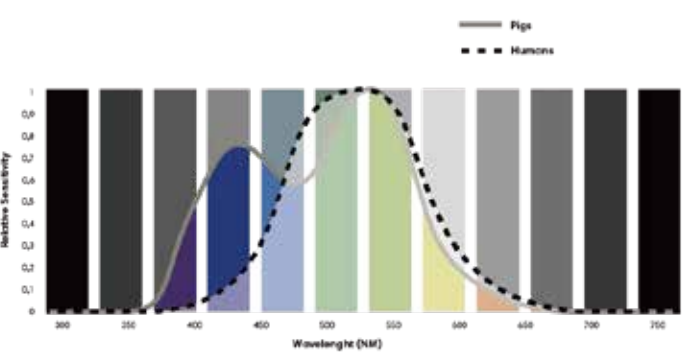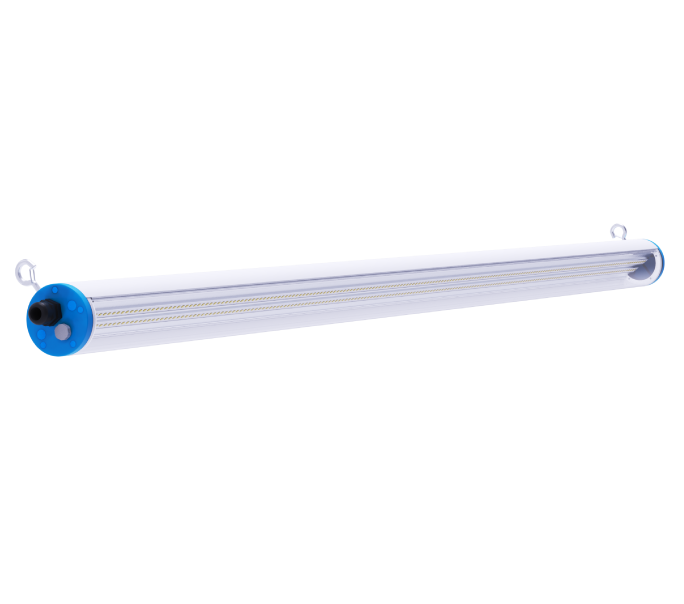.png)
What Is Important in Swine Production Regarding Lighting?
LED Lighting for Swine Production
Proper swine lighting is essential to ensure optimal health, growth, and welfare in modern pig farming. Light influences nearly every physiological and behavioral process in pigs — from hormone regulation and feeding rhythm to reproduction and immune performance.
Understanding how pigs perceive and respond to light enables farmers to create a comfortable, stress-free environment that promotes both welfare and productivity.
 (1).png)
Visual Characteristics of Swine
Swine have a panoramic field of vision of around 330°, giving them excellent awareness of their surroundings. They rely heavily on monocular vision (one eye at a time), which helps detect motion and potential threats. However, their binocular vision is limited, meaning pigs cannot accurately perceive depth or judge distances as well as humans.
This visual limitation has practical implications in barn design and lighting placement:
Uniform illumination across aisles and pens helps pigs navigate safely.
Avoiding glare or sudden brightness changes prevents fear responses or hesitation during movement.
Good lighting therefore improves not only welfare but also handling efficiency and animal safety.
.jpg)
Visible Spectrum and Spectral Sensitivity
The visible light spectrum—the portion of electromagnetic radiation perceived as light—differs between species. While humans perceive wavelengths roughly between 380 nm and 780 nm, pigs’ visible range is narrower, from approximately 380 to 694 nm, with peak sensitivities at 439 nm (blue) and 556 nm (green).
This means pigs are less sensitive to red light and respond best to blue-green wavelengths. Lighting that takes this into account can better support pigs’ natural biological rhythms and behaviour.
Types of Spectral Sensitivity:
1. Cone Sensitivity: Determined by the types of cones and rods in the retina. Pigs are dichromatic, meaning they have two types of color receptors.
2. Behavioral Sensitivity: Relates to how pigs respond to light in their environment — more relevant for welfare and productivity.
3. Research shows that light spectrum, intensity, and photoperiod all interact to influence hormonal regulation, particularly melatonin and reproductive hormones, which in turn affect growth rate, fertility, and stress levels.

Photoperiod and Lighting Regime
An effective lighting regime balances light and dark periods to simulate natural day–night cycles.
Recommended photoperiod: 14–16 hours of light and 8–10 hours of darkness
Optimal intensity: At least 150–200 lux at animal eye level for finishing pigs; higher for gestation and lactation areas
Color temperature: 4000–5000K (neutral white) supports natural circadian activity
Proper light scheduling helps regulate melatonin production, which influences feeding patterns, reproduction, and immune response. Continuous lighting or inconsistent light schedules can cause stress and reduce productivity.
.png)
Welfare and Behavioral Benefits of Proper Lighting
Adapting light to pigs’ visual and behavioral needs offers multiple measurable benefits:
Improved vision and spatial awareness – Pigs move more confidently, reducing falls and injury.
Enhanced reproductive performance – Proper light exposure supports estrus detection and fertility in sows.
Better feeding behavior – Pigs under stable light conditions show increased feed intake and improved growth rates.
Reduced stress and aggression – Calmer herds with fewer fights or dominance displays.
Stronger immune function – Consistent circadian rhythm contributes to overall resilience.
Lighting should not be viewed as mere visibility — it’s a biological control tool that directly influences animal welfare and farm economics.
 (1).png)
Swine Barn LED Lights
Ceramiclite T16 swine barn LED light is an excellent solution specifically designed for livestock harsh environments requiring high-pressure washing. Made from special plastic with a waterproof structure and fluorescent transparent ceramic LED light source, the durability reduces maintenance costs, while their long lifespan and energy efficiency provide superior lighting, especially suitable for swine farms, industrial sites, and food processing facilities.

Thanks for your enquiry, we will contact ASAP.
Something went wrong...
_thumb.jpg)